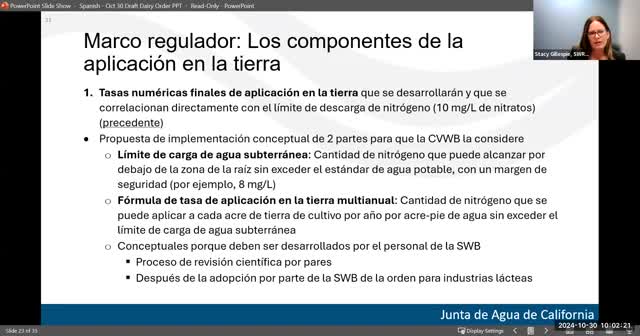Central Valley Water Board proposes groundbreaking dairy nitrogen regulations
November 01, 2024 | State Water Resources Control Board, Agencies under Office of the Governor, Executive, California
This article was created by AI summarizing key points discussed. AI makes mistakes, so for full details and context, please refer to the video of the full meeting. Please report any errors so we can fix them. Report an error »

In a recent government meeting, officials discussed a comprehensive two-part proposal aimed at regulating nitrogen application rates for dairy operations in California's Central Valley. This proposal is part of a broader effort to ensure compliance with drinking water standards and to mitigate environmental impacts from agricultural practices.
The first component of the proposal introduces a groundwater loading limit, which specifies the permissible amount of nitrogen that can seep below the root zone of cropland. This limit is designed to protect drinking water quality and includes a safety margin. However, the proposal emphasizes that establishing this limit alone will not guarantee compliance. Therefore, the second part involves creating a multi-year land application rate formula. This formula will guide dairy operators on the maximum nitrogen that can be applied per acre of cropland annually, factoring in variables such as crop uptake and denitrification.
These elements are still conceptual and will be developed by the state water board in collaboration with the Central Valley Water Board, utilizing a scientific peer review process. Following the adoption of the final dairy order, the state water board will provide these guidelines for consideration in the revised general Waste Discharge Requirements (WDRs).
The framework also mandates the Central Valley Water Board to set timelines for existing dairies to comply with the new numeric land application rates, with a maximum compliance period of 35 years. This timeline acknowledges the current limitations in the dairy industry regarding alternative waste management solutions. In contrast, new dairies will be required to comply immediately with the nitrogen discharge limits.
Additionally, the framework calls for the establishment of interim numeric land application rates to gradually reduce manure application until the final rates are achieved. The Central Valley Water Board will have the discretion to determine specific milestones and deadlines, although the state water board recommends considering a whole farm nitrogen balance as an interim milestone.
A significant aspect of the proposal is the requirement for a whole farm nitrogen accounting method, which will help dairies track nitrogen generation and its management. This method will be developed in consultation with technical experts and stakeholders to ensure scientific rigor.
The draft order also includes various technical measures aimed at enhancing land application practices, with specific reporting requirements for irrigation and nitrogen management that are expected to set a precedent for other regions. These discussions mark a critical step towards improving environmental stewardship within California's dairy industry.
The first component of the proposal introduces a groundwater loading limit, which specifies the permissible amount of nitrogen that can seep below the root zone of cropland. This limit is designed to protect drinking water quality and includes a safety margin. However, the proposal emphasizes that establishing this limit alone will not guarantee compliance. Therefore, the second part involves creating a multi-year land application rate formula. This formula will guide dairy operators on the maximum nitrogen that can be applied per acre of cropland annually, factoring in variables such as crop uptake and denitrification.
These elements are still conceptual and will be developed by the state water board in collaboration with the Central Valley Water Board, utilizing a scientific peer review process. Following the adoption of the final dairy order, the state water board will provide these guidelines for consideration in the revised general Waste Discharge Requirements (WDRs).
The framework also mandates the Central Valley Water Board to set timelines for existing dairies to comply with the new numeric land application rates, with a maximum compliance period of 35 years. This timeline acknowledges the current limitations in the dairy industry regarding alternative waste management solutions. In contrast, new dairies will be required to comply immediately with the nitrogen discharge limits.
Additionally, the framework calls for the establishment of interim numeric land application rates to gradually reduce manure application until the final rates are achieved. The Central Valley Water Board will have the discretion to determine specific milestones and deadlines, although the state water board recommends considering a whole farm nitrogen balance as an interim milestone.
A significant aspect of the proposal is the requirement for a whole farm nitrogen accounting method, which will help dairies track nitrogen generation and its management. This method will be developed in consultation with technical experts and stakeholders to ensure scientific rigor.
The draft order also includes various technical measures aimed at enhancing land application practices, with specific reporting requirements for irrigation and nitrogen management that are expected to set a precedent for other regions. These discussions mark a critical step towards improving environmental stewardship within California's dairy industry.
View full meeting
This article is based on a recent meeting—watch the full video and explore the complete transcript for deeper insights into the discussion.
View full meeting
